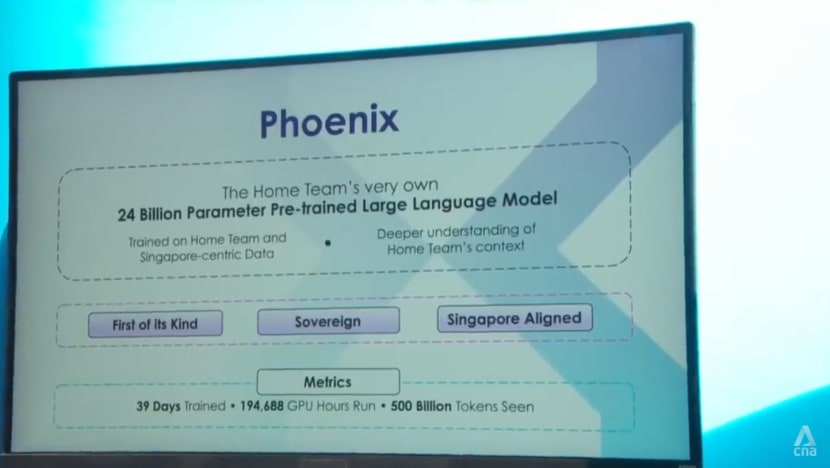Humanoid robots to assist Home Team frontliners by mid-2027, says Singapore's HTX
SINGAPORE: Singapore's Home Team Science and Technology Agency (HTX) is looking to give Home Team officers an extra hand by mid-2027 with the help of humanoid robots.
These robots will be deployed in high-risk situations like fighting fires, helping out in post-disaster search and rescue operations, and handling hazardous materials.
HTX is aiming for them to be remotely controlled by 2027 and then operate autonomously by 2029 with the help of AI.
Some of these robots, which are currently undergoing trials, were exhibited at the opening of HTX’s AI TechXplore event that began on Monday (May 26).
The agency was showcasing its latest projects as well as research and development (R&D) work in the AI field.
"This initiative marks a fundamental shift in the development of robotics capabilities in the Home Team – from today's pre-programmed systems to tomorrow's GenAI-powered intelligent platforms that can move, think, and act autonomously to protect and save lives," said Minister for Digital Development and Information Josephine Teo, who spoke at the event.
HTX also launched a new S$100 million (US$78 million) robotic research facility that will focus on developing humanoid robotic capabilities of the Home Team.
The facility, known as the Home Team Humanoid Robotics Centre (H2RC), will be up and running by next year, according to the agency.
It is designed to provide specialised settings for training and validating AI-enabled robots that will take over high-risk tasks from humans.
ADOPTION OF ROBOTICS
Professor Louis Phee, vice president of innovation and entrepreneurship at Nanyang Technological University (NTU), said that while humanoid robots will be assigned with the riskier tasks in missions such as firefighting, existing challenges in hardware and software need to be overcome.
Such tasks require smooth movements in the robots’ hardware, as well as the use of large language models trained in the Singapore context, he added.
This will allow a robot to properly communicate with other humanoid robots and human beings, Prof Phee told CNA’s Singapore Tonight programme.
"Imagine if you buy a robotic system from Europe, that robotic system may not be able to understand how Singaporean(s) speak. But with our own … specific Singaporean large language models … that's where the humans and the humanlike robots can better connect and understand each other," he added.
He said widespread integration of humanoid robots into daily life requires a delicate balance between giving such robots full autonomy and ensuring the safety of humans.
When asked how ready Singapore’s society is to accept such robots, he pointed to the country’s manpower shortage and how it embraces technology.
He compared it to the field of surgical robotics where attitudes have shifted from patients demanding a human surgeon years ago, to patients now preferring a robot due to higher accuracy.
"So, it will take time," he added.
USING AI TO BOOST EFFICIENCY
Apart from robotic assistance, HTX said it will also look at more than 300 AI use cases that help streamline communication and workflows for responders, with the first to be operational as early as the end of the year.
One tool that reduces the risks to first responders is an AI system that will take real-time audio and video recordings of a crisis, such as a fire.
The system will then use AI to provide analysis and recommendations for teams that are enroute to the incident, speeding up response times.
HTX said this analysis tool could potentially boost first responders’ productivity by 30 per cent.
The agency also announced that Home Team officers will have access to an AI chatbot that runs on a localised language learning model (LLM).
The AI chatbot, called Phoenix, has been trained by HTX’s partner Mistral AI on knowledge specific and relevant to Singapore’s local context, as well as 10 major languages spoken in Singapore, such as Mandarin, Bahasa Melayu and Tamil.

"It understands things like our terminology, our hierarchy, our internal SOPs (standard operating procedures) and laws and rules," said Arka Ray, lead engineer at HTX’s Q Team.
"And all of these things are conveyed naturally by the training that we do so that the officer can just do what they need to do best, which is the analysis," she added.
She said this allows Home Team officers to get more accurate responses from the chatbot, compared to other LLMs that have not been trained on relevant local data.
The agency will progressively deploy Phoenix to Home Team officers, and as an application programming interface (API) for AI developers to build operational applications.
To develop more such applications, HTX said it is looking to fill more than 150 positions across its AI workforce.
Disclaimer: Investing carries risk. This is not financial advice. The above content should not be regarded as an offer, recommendation, or solicitation on acquiring or disposing of any financial products, any associated discussions, comments, or posts by author or other users should not be considered as such either. It is solely for general information purpose only, which does not consider your own investment objectives, financial situations or needs. TTM assumes no responsibility or warranty for the accuracy and completeness of the information, investors should do their own research and may seek professional advice before investing.
Most Discussed
- 1
- 2
- 3
- 4
- 5
- 6
- 7
- 8
- 9
- 10